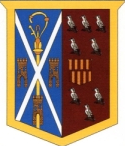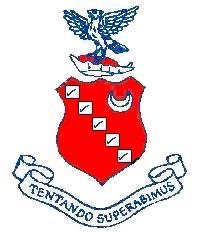
Plympton is a suburb of the city of Plymouth in Devon, England. It is in origin an ancient stannary town. It was an important trading centre for locally mined tin, and a seaport before the River Plym silted up and trade moved down river to Plymouth and was the seat of Plympton Priory the most significant local landholder for many centuries.

Calderstones School is an English comprehensive school located opposite Calderstones Park on Harthill Road in the Liverpool suburb of Allerton.

St Cuthbert's Catholic High School is a boys-only Roman Catholic secondary school with academy status located on Gretna Road in Newcastle upon Tyne, England.

Exeter College is a general further education college in Exeter, Devon; it was first such college in England, and was the highest-ranked in the country in 2017. The college has its origins in the Royal Albert Memorial Museum, founded in 1869, and first became an independent institution in 1893 as the Exeter Technical and University Extension College. After using various different sites, the college's preceding institution moved into its present main campus in 1959, and was established in its present form as the first English further education college in 1970. The majority of its present buildings were constructed from 2005 onward.
Sunderland College, officially City of Sunderland College, is a further education and higher education college based in Sunderland, North East England. The enrolment includes around 6,300 part-time learners and approximately 4,800 full-time students. A report following a January 2010 Ofsted inspection awarded the school a Grade 2 (good) that included a Grade 1 (outstanding) on 3 inspection criteria. The college is a member of the Collab Group of high performing schools.

Mulberry Academy Woodside is a mixed 11–16 academy located in the Wood Green area of the London Borough of Haringey, England. With a student roll of 1200, the school has been judged by Ofsted as outstanding for two consecutive inspections.
Hele's School, formerly Plympton Grammar School, is a co-educational Academy school and Sixth Form in the Plympton district of Plymouth, England, 6 miles (9.7 km) east of Plymouth city centre. Until 31 March 2011, Hele’s was a community school funded by the Local Education Authority (LEA), which is Plymouth City Council. From 1 April 2011, Hele's became an Academy, which among other things gives the school financial and educational independence. The school has a voluntary Combined Cadet Force with Navy, Army and RAF sections. Cadets in the CCF are given the option to take part in the annual Ten Tors Challenge on Dartmoor.
Dover Grammar School for Boys (DGSB) is a selective secondary school located in Dover, United Kingdom, whose origins can be traced back to the Education Act 1902 (the 'Balfour Act'). Originally founded as the Dover County School for Boys and Girls with locations behind the Dover Town Hall and on Priory Hill, the co-educational arrangements were early on prohibited by the Kent Education Committee. Dover Grammar School for Boys now occupies a prominent position overlooking the town of Dover on Astor Avenue. Its sister school is located in Frith Road and known as the Dover Grammar School for Girls (DGSG).

The Maynard School is an private selective day school for girls aged 4–18 in the city of Exeter in Devon. Founded in 1658, the school is the second oldest girls' school in the country, only predated by the Redmaids' High School in Bristol (1634). Its previous mission statement under Ms. Hughes was 'Imagine, Aspire, Achieve' and has changed more recently to #Madeforgirls.
Tollington School (1901-1967) was a selective, coeducational grammar school in Muswell Hill, London, England. For the present school on this site, see Fortismere School.

Elize Hele (1560–1635) of Fardel in the parish of Cornwood, Devon and of Parke in the parish of Bovey Tracey, Devon, was an English lawyer and philanthropist. In 1632 he transferred his lands into a trust intended for "pious uses", from which charitable action and in order to distinguish him from his many prominent relations, he became known to posterity as "Pious Uses Hele", which his biographer Prince looked upon "as a more honourable appellation than the greatest empty title". The trustees included his wife, together with John Hele and a number of friends. The trust was used to create a number of schools in Devon including Plympton Grammar School.
Gateshead Grammar School was a school in Gateshead, Tyne and Wear, England, that operated from 1883 to 1967.
Surbiton County Grammar was a school in Surbiton on the borders of London and Surrey. Established in the 1920s, the school later moved to Thames Ditton and changed its name to Esher County Grammar School. The last grammar school pupils were admitted in 1974, and by 1979 the site had become a sixth form college. The school was attended by boys from the whole of north Surrey.

Stretford Grammar School is a grammar school located in Stretford, in the Trafford borough of Greater Manchester, England. It is located on a 15-acre plot in the heart of Stretford, Trafford.

Manchester Academy is a coeducational secondary school within the English Academy programme, in Moss Side, Manchester. It is situated on Moss Lane East (B5219), near Denmark Road, with the University of Manchester nearby to the north and the Whitworth Art Gallery to the east.

Beckfoot Upper Heaton is a co-educational secondary school in Bradford, West Yorkshire, England. It is situated near the Hallmark Cards factory, not far from Bingley Road (B6269).

Tottenham Grammar School (TGS) was a grammar school in North London, with local football connections. Its history goes back beyond the 1631 bequest by the Duchess of Somerset. It closed in 1988, but it created the Tottenham Grammar School Foundation.
Hele, Hélé, or Hèle may refer to:
Wyggeston Grammar School for Boys was a grammar school in Leicester, England, in existence from 1876 to 1976.

Parke is an historic estate in the parish of Bovey Tracey in Devon, England. The present mansion house known as Parke House, a grade II listed building situated 1/2 mile west of the centre of the town of Bovey Tracey and on the opposite side of the River Bovey, was rebuilt in 1826/8 by William Hole (1799-1859) and is today the headquarters of the Dartmoor National Park Authority.













